Data and System Integration in Healthcare: Benefits and Challenges
VerifiedAdded on 2023/06/12
|16
|3207
|491
AI Summary
The report discusses the benefits and challenges of data and system integration in healthcare. It covers the Enterprise Information Architecture Reference Architecture, the benefits of implementing the EHR system, information management and integration, and data sensitivity challenges. The report concludes with recommendations for proper action planning and shared learning.
Contribute Materials
Your contribution can guide someone’s learning journey. Share your
documents today.
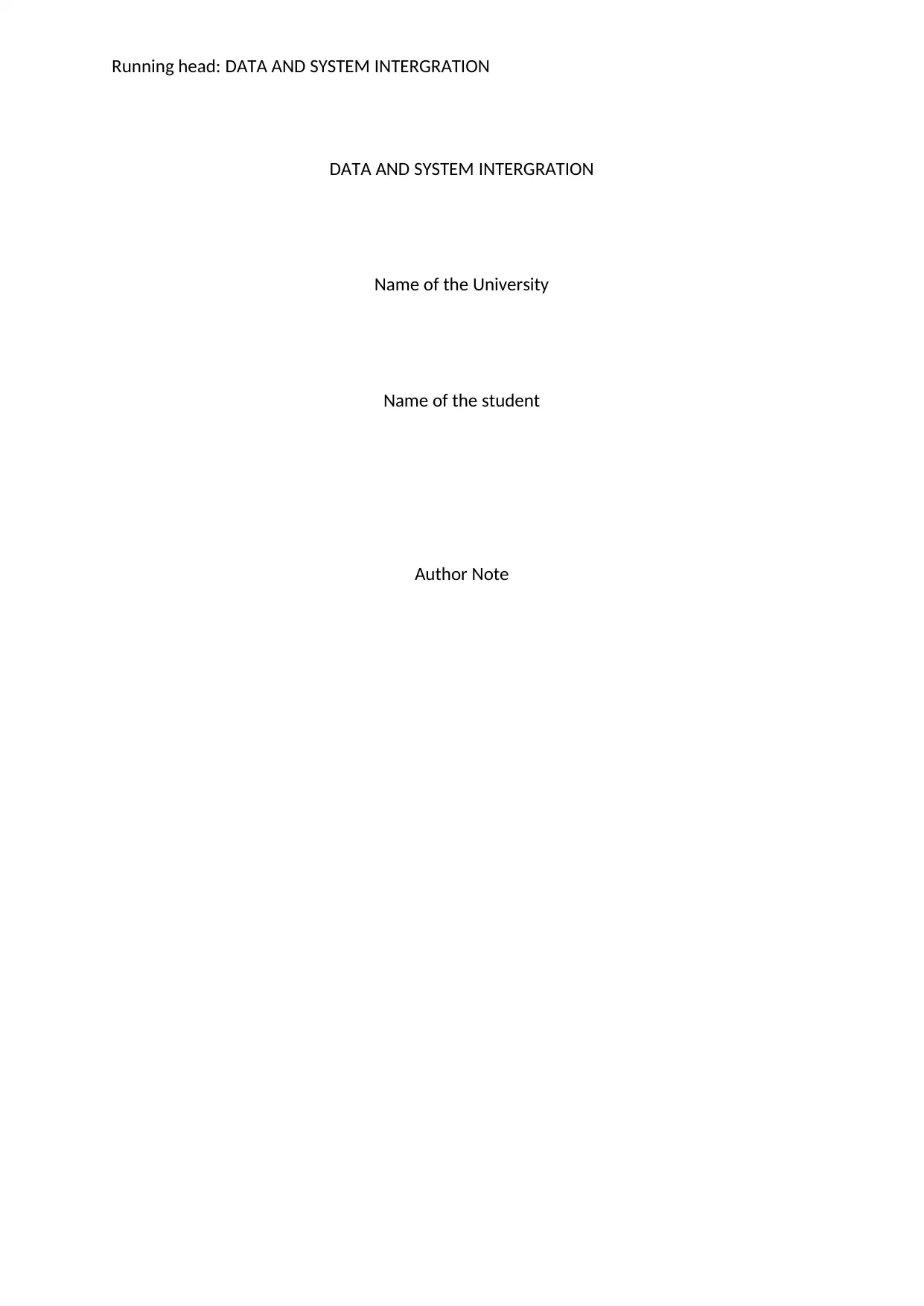
Running head: DATA AND SYSTEM INTERGRATION
DATA AND SYSTEM INTERGRATION
Name of the University
Name of the student
Author Note
DATA AND SYSTEM INTERGRATION
Name of the University
Name of the student
Author Note
Secure Best Marks with AI Grader
Need help grading? Try our AI Grader for instant feedback on your assignments.
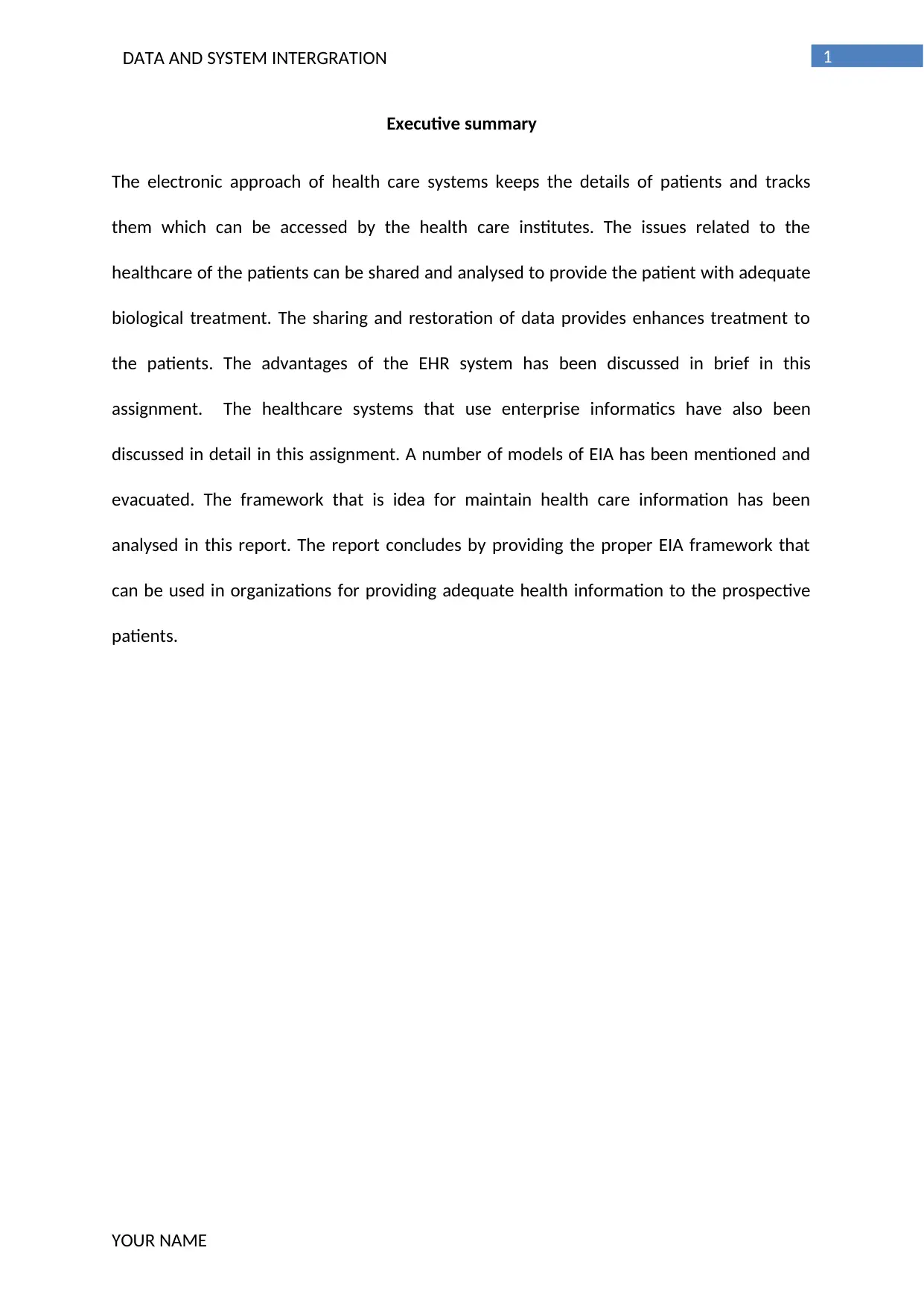
1DATA AND SYSTEM INTERGRATION
Executive summary
The electronic approach of health care systems keeps the details of patients and tracks
them which can be accessed by the health care institutes. The issues related to the
healthcare of the patients can be shared and analysed to provide the patient with adequate
biological treatment. The sharing and restoration of data provides enhances treatment to
the patients. The advantages of the EHR system has been discussed in brief in this
assignment. The healthcare systems that use enterprise informatics have also been
discussed in detail in this assignment. A number of models of EIA has been mentioned and
evacuated. The framework that is idea for maintain health care information has been
analysed in this report. The report concludes by providing the proper EIA framework that
can be used in organizations for providing adequate health information to the prospective
patients.
YOUR NAME
Executive summary
The electronic approach of health care systems keeps the details of patients and tracks
them which can be accessed by the health care institutes. The issues related to the
healthcare of the patients can be shared and analysed to provide the patient with adequate
biological treatment. The sharing and restoration of data provides enhances treatment to
the patients. The advantages of the EHR system has been discussed in brief in this
assignment. The healthcare systems that use enterprise informatics have also been
discussed in detail in this assignment. A number of models of EIA has been mentioned and
evacuated. The framework that is idea for maintain health care information has been
analysed in this report. The report concludes by providing the proper EIA framework that
can be used in organizations for providing adequate health information to the prospective
patients.
YOUR NAME
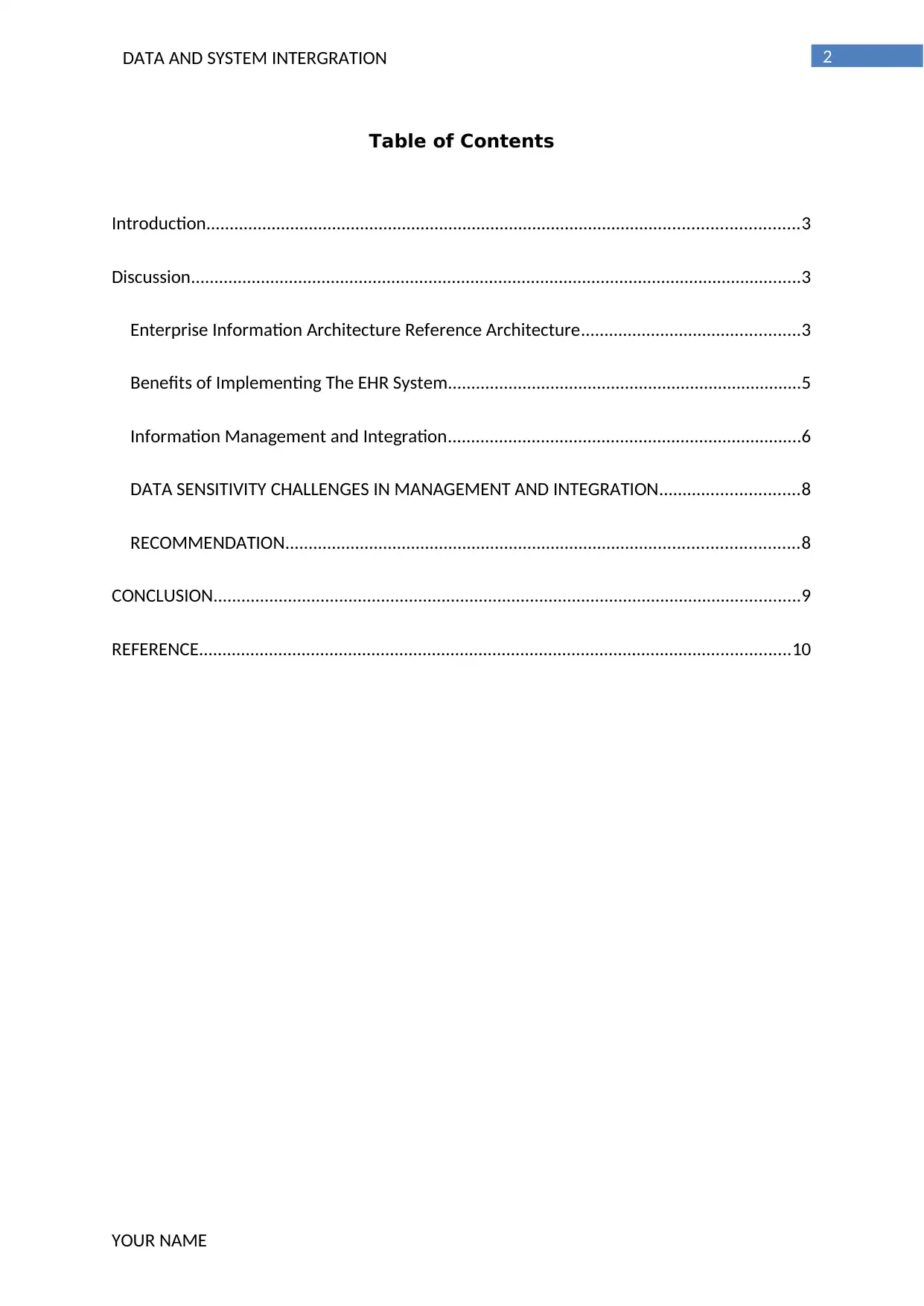
2DATA AND SYSTEM INTERGRATION
Table of Contents
Introduction...............................................................................................................................3
Discussion...................................................................................................................................3
Enterprise Information Architecture Reference Architecture...............................................3
Benefits of Implementing The EHR System............................................................................5
Information Management and Integration............................................................................6
DATA SENSITIVITY CHALLENGES IN MANAGEMENT AND INTEGRATION..............................8
RECOMMENDATION..............................................................................................................8
CONCLUSION..............................................................................................................................9
REFERENCE...............................................................................................................................10
YOUR NAME
Table of Contents
Introduction...............................................................................................................................3
Discussion...................................................................................................................................3
Enterprise Information Architecture Reference Architecture...............................................3
Benefits of Implementing The EHR System............................................................................5
Information Management and Integration............................................................................6
DATA SENSITIVITY CHALLENGES IN MANAGEMENT AND INTEGRATION..............................8
RECOMMENDATION..............................................................................................................8
CONCLUSION..............................................................................................................................9
REFERENCE...............................................................................................................................10
YOUR NAME
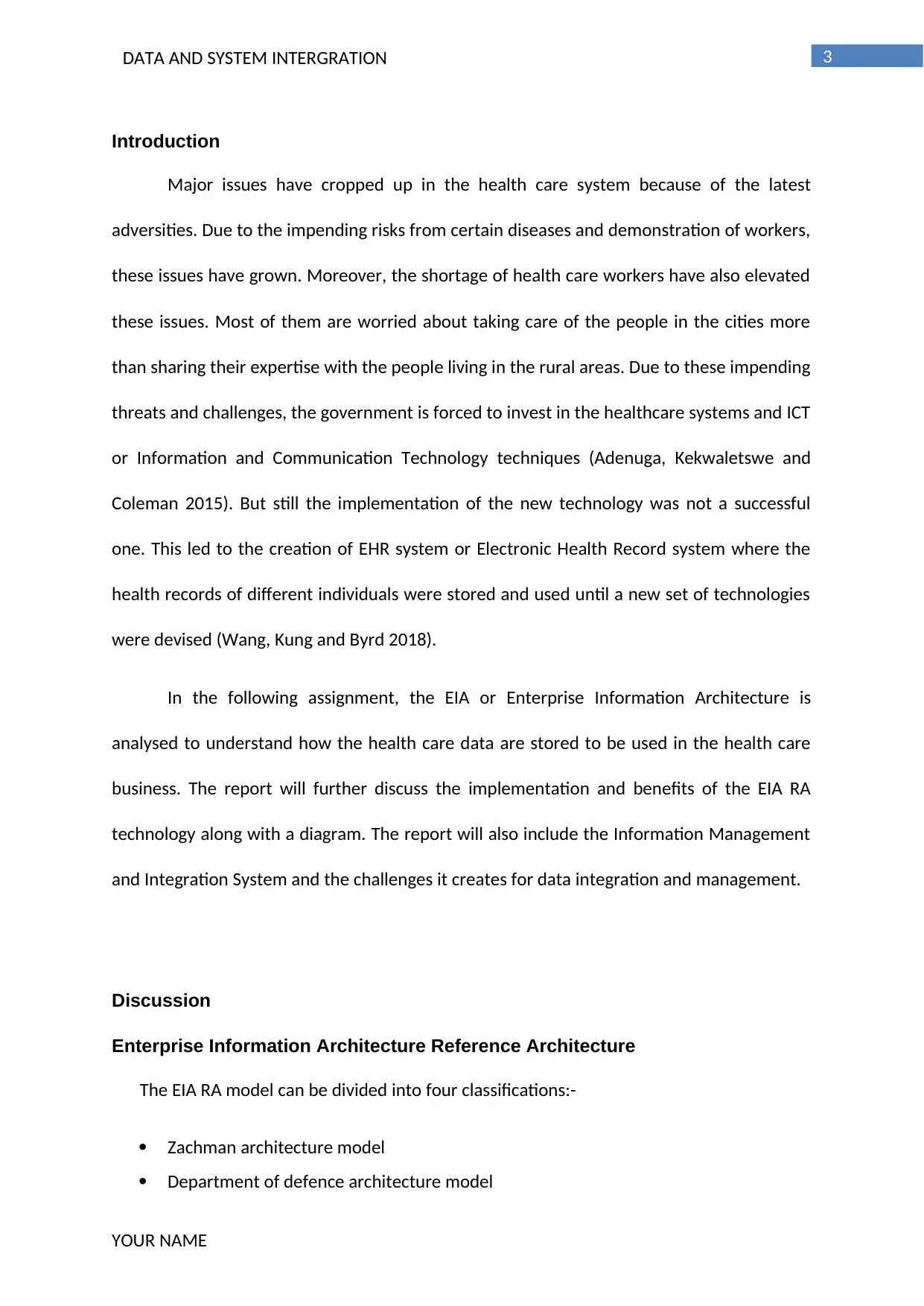
3DATA AND SYSTEM INTERGRATION
Introduction
Major issues have cropped up in the health care system because of the latest
adversities. Due to the impending risks from certain diseases and demonstration of workers,
these issues have grown. Moreover, the shortage of health care workers have also elevated
these issues. Most of them are worried about taking care of the people in the cities more
than sharing their expertise with the people living in the rural areas. Due to these impending
threats and challenges, the government is forced to invest in the healthcare systems and ICT
or Information and Communication Technology techniques (Adenuga, Kekwaletswe and
Coleman 2015). But still the implementation of the new technology was not a successful
one. This led to the creation of EHR system or Electronic Health Record system where the
health records of different individuals were stored and used until a new set of technologies
were devised (Wang, Kung and Byrd 2018).
In the following assignment, the EIA or Enterprise Information Architecture is
analysed to understand how the health care data are stored to be used in the health care
business. The report will further discuss the implementation and benefits of the EIA RA
technology along with a diagram. The report will also include the Information Management
and Integration System and the challenges it creates for data integration and management.
Discussion
Enterprise Information Architecture Reference Architecture
The EIA RA model can be divided into four classifications:-
Zachman architecture model
Department of defence architecture model
YOUR NAME
Introduction
Major issues have cropped up in the health care system because of the latest
adversities. Due to the impending risks from certain diseases and demonstration of workers,
these issues have grown. Moreover, the shortage of health care workers have also elevated
these issues. Most of them are worried about taking care of the people in the cities more
than sharing their expertise with the people living in the rural areas. Due to these impending
threats and challenges, the government is forced to invest in the healthcare systems and ICT
or Information and Communication Technology techniques (Adenuga, Kekwaletswe and
Coleman 2015). But still the implementation of the new technology was not a successful
one. This led to the creation of EHR system or Electronic Health Record system where the
health records of different individuals were stored and used until a new set of technologies
were devised (Wang, Kung and Byrd 2018).
In the following assignment, the EIA or Enterprise Information Architecture is
analysed to understand how the health care data are stored to be used in the health care
business. The report will further discuss the implementation and benefits of the EIA RA
technology along with a diagram. The report will also include the Information Management
and Integration System and the challenges it creates for data integration and management.
Discussion
Enterprise Information Architecture Reference Architecture
The EIA RA model can be divided into four classifications:-
Zachman architecture model
Department of defence architecture model
YOUR NAME
Secure Best Marks with AI Grader
Need help grading? Try our AI Grader for instant feedback on your assignments.
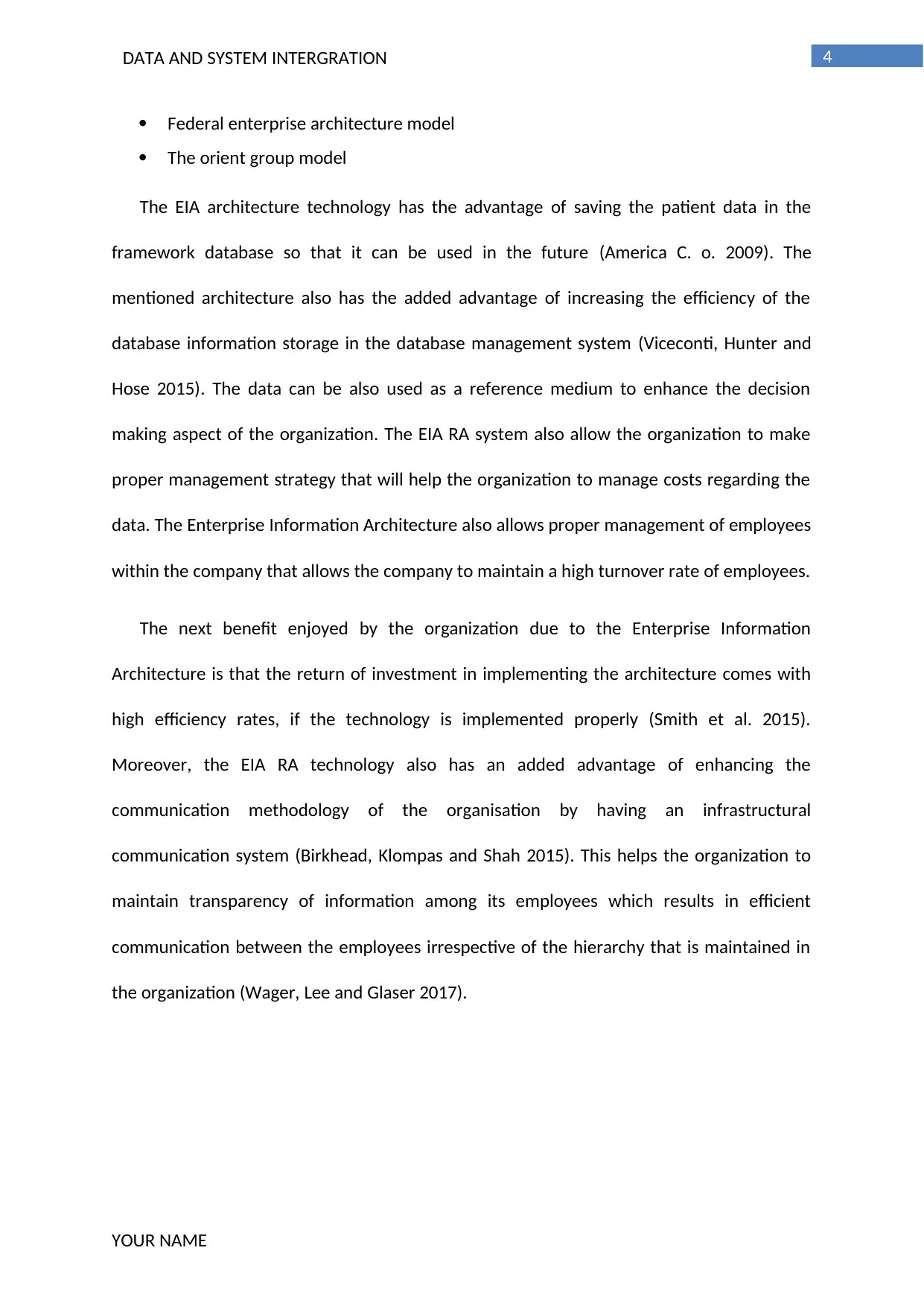
4DATA AND SYSTEM INTERGRATION
Federal enterprise architecture model
The orient group model
The EIA architecture technology has the advantage of saving the patient data in the
framework database so that it can be used in the future (America C. o. 2009). The
mentioned architecture also has the added advantage of increasing the efficiency of the
database information storage in the database management system (Viceconti, Hunter and
Hose 2015). The data can be also used as a reference medium to enhance the decision
making aspect of the organization. The EIA RA system also allow the organization to make
proper management strategy that will help the organization to manage costs regarding the
data. The Enterprise Information Architecture also allows proper management of employees
within the company that allows the company to maintain a high turnover rate of employees.
The next benefit enjoyed by the organization due to the Enterprise Information
Architecture is that the return of investment in implementing the architecture comes with
high efficiency rates, if the technology is implemented properly (Smith et al. 2015).
Moreover, the EIA RA technology also has an added advantage of enhancing the
communication methodology of the organisation by having an infrastructural
communication system (Birkhead, Klompas and Shah 2015). This helps the organization to
maintain transparency of information among its employees which results in efficient
communication between the employees irrespective of the hierarchy that is maintained in
the organization (Wager, Lee and Glaser 2017).
YOUR NAME
Federal enterprise architecture model
The orient group model
The EIA architecture technology has the advantage of saving the patient data in the
framework database so that it can be used in the future (America C. o. 2009). The
mentioned architecture also has the added advantage of increasing the efficiency of the
database information storage in the database management system (Viceconti, Hunter and
Hose 2015). The data can be also used as a reference medium to enhance the decision
making aspect of the organization. The EIA RA system also allow the organization to make
proper management strategy that will help the organization to manage costs regarding the
data. The Enterprise Information Architecture also allows proper management of employees
within the company that allows the company to maintain a high turnover rate of employees.
The next benefit enjoyed by the organization due to the Enterprise Information
Architecture is that the return of investment in implementing the architecture comes with
high efficiency rates, if the technology is implemented properly (Smith et al. 2015).
Moreover, the EIA RA technology also has an added advantage of enhancing the
communication methodology of the organisation by having an infrastructural
communication system (Birkhead, Klompas and Shah 2015). This helps the organization to
maintain transparency of information among its employees which results in efficient
communication between the employees irrespective of the hierarchy that is maintained in
the organization (Wager, Lee and Glaser 2017).
YOUR NAME
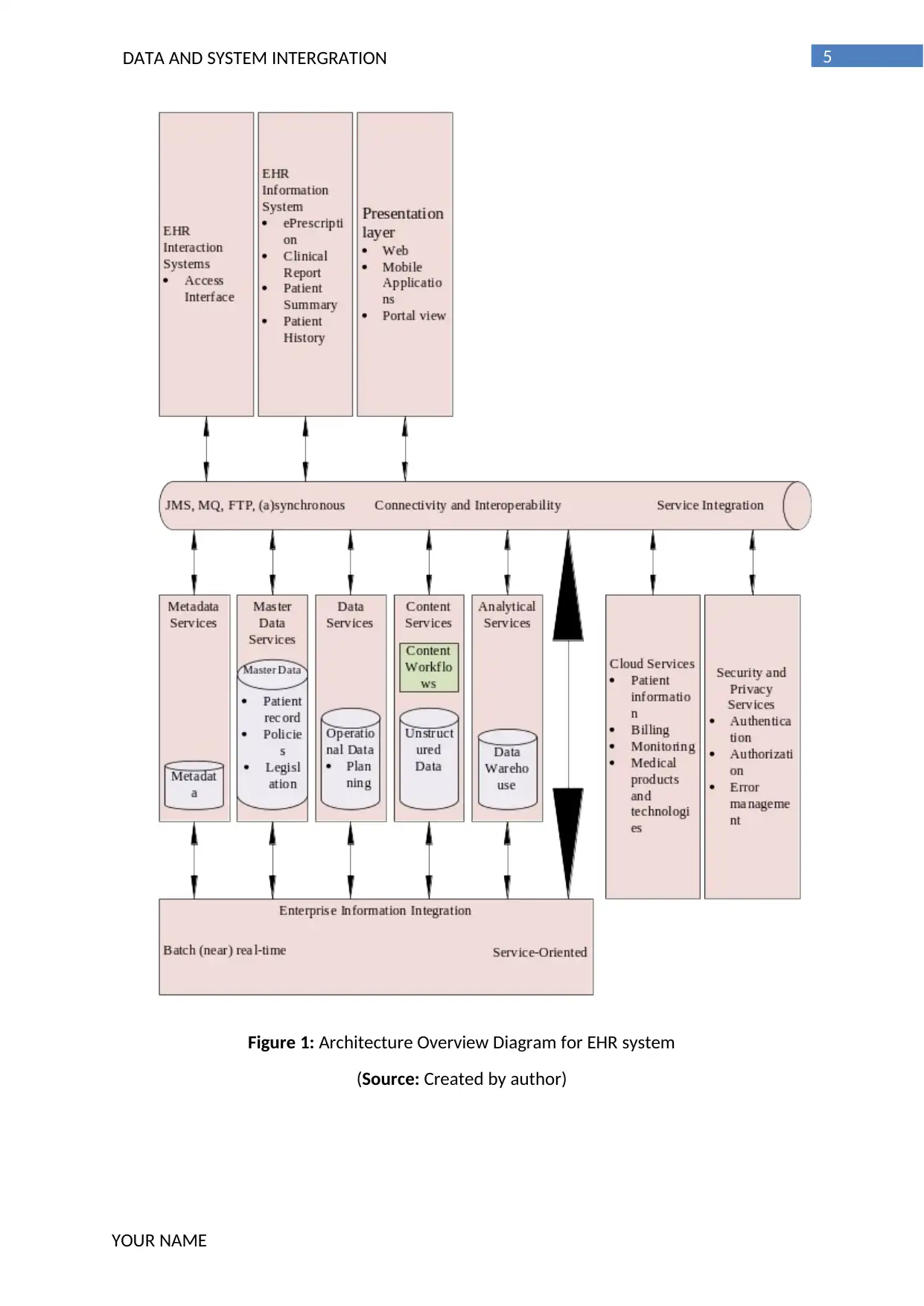
5DATA AND SYSTEM INTERGRATION
Figure 1: Architecture Overview Diagram for EHR system
(Source: Created by author)
YOUR NAME
Figure 1: Architecture Overview Diagram for EHR system
(Source: Created by author)
YOUR NAME
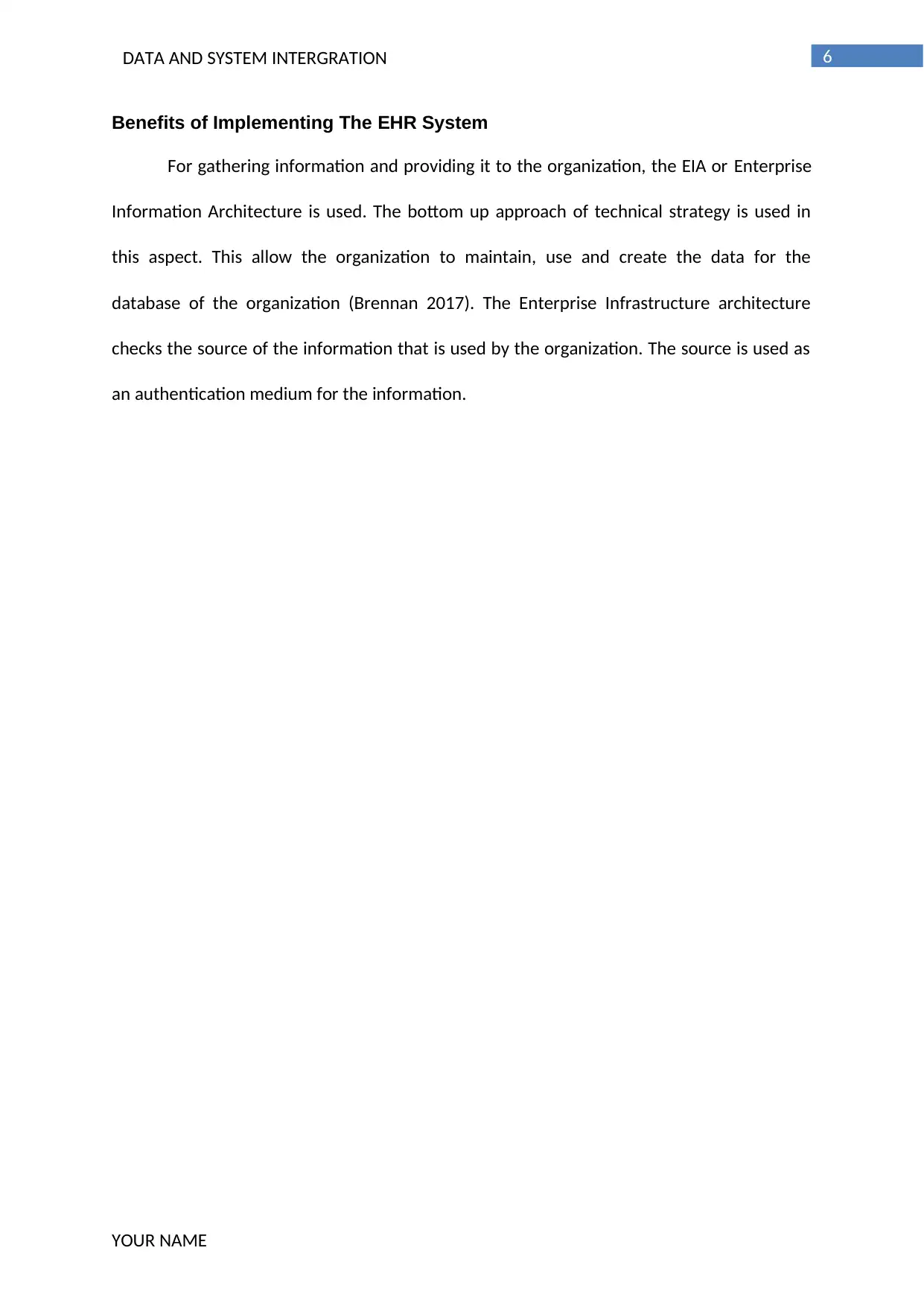
6DATA AND SYSTEM INTERGRATION
Benefits of Implementing The EHR System
For gathering information and providing it to the organization, the EIA or Enterprise
Information Architecture is used. The bottom up approach of technical strategy is used in
this aspect. This allow the organization to maintain, use and create the data for the
database of the organization (Brennan 2017). The Enterprise Infrastructure architecture
checks the source of the information that is used by the organization. The source is used as
an authentication medium for the information.
YOUR NAME
Benefits of Implementing The EHR System
For gathering information and providing it to the organization, the EIA or Enterprise
Information Architecture is used. The bottom up approach of technical strategy is used in
this aspect. This allow the organization to maintain, use and create the data for the
database of the organization (Brennan 2017). The Enterprise Infrastructure architecture
checks the source of the information that is used by the organization. The source is used as
an authentication medium for the information.
YOUR NAME
Paraphrase This Document
Need a fresh take? Get an instant paraphrase of this document with our AI Paraphraser
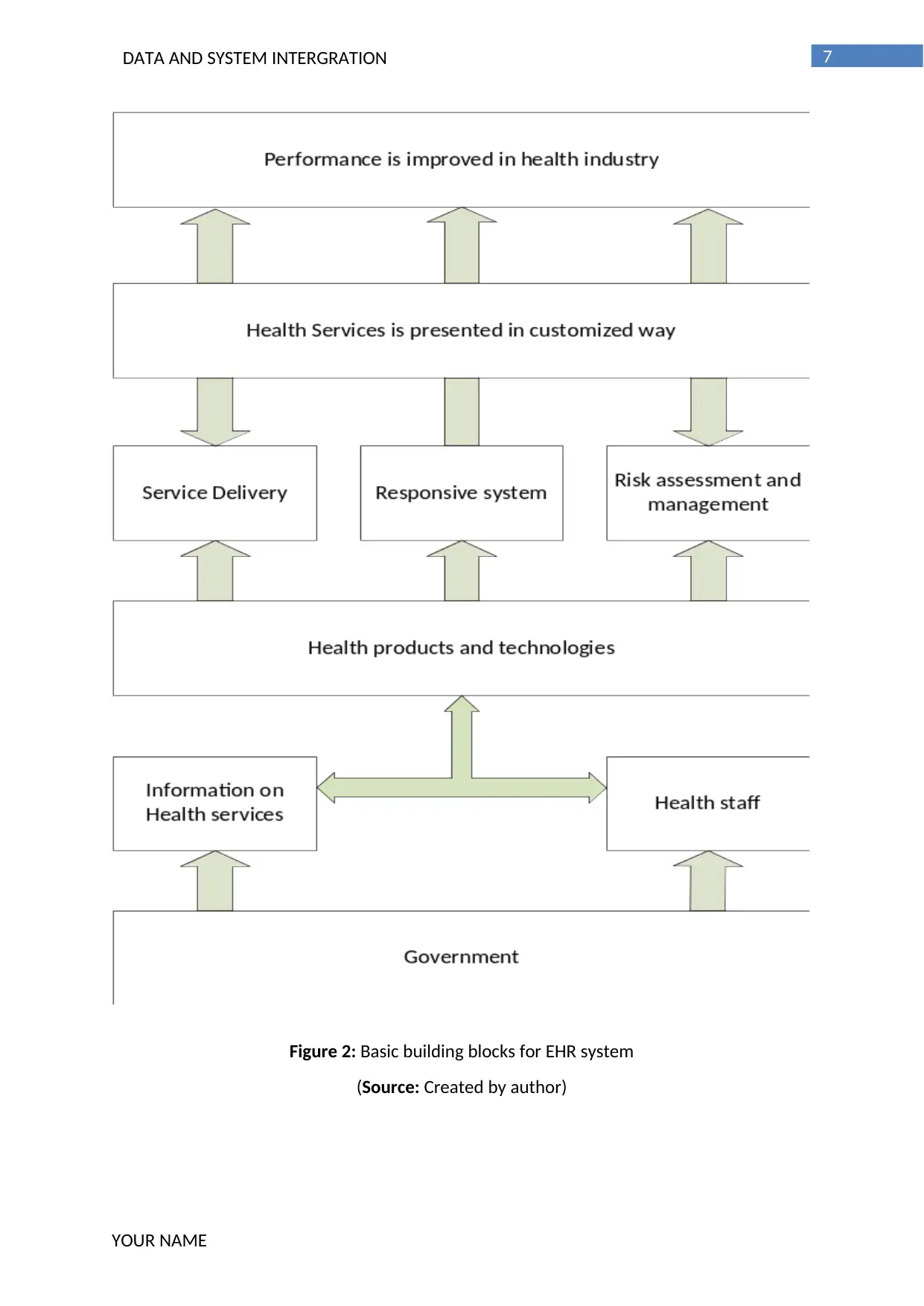
7DATA AND SYSTEM INTERGRATION
Figure 2: Basic building blocks for EHR system
(Source: Created by author)
YOUR NAME
Figure 2: Basic building blocks for EHR system
(Source: Created by author)
YOUR NAME
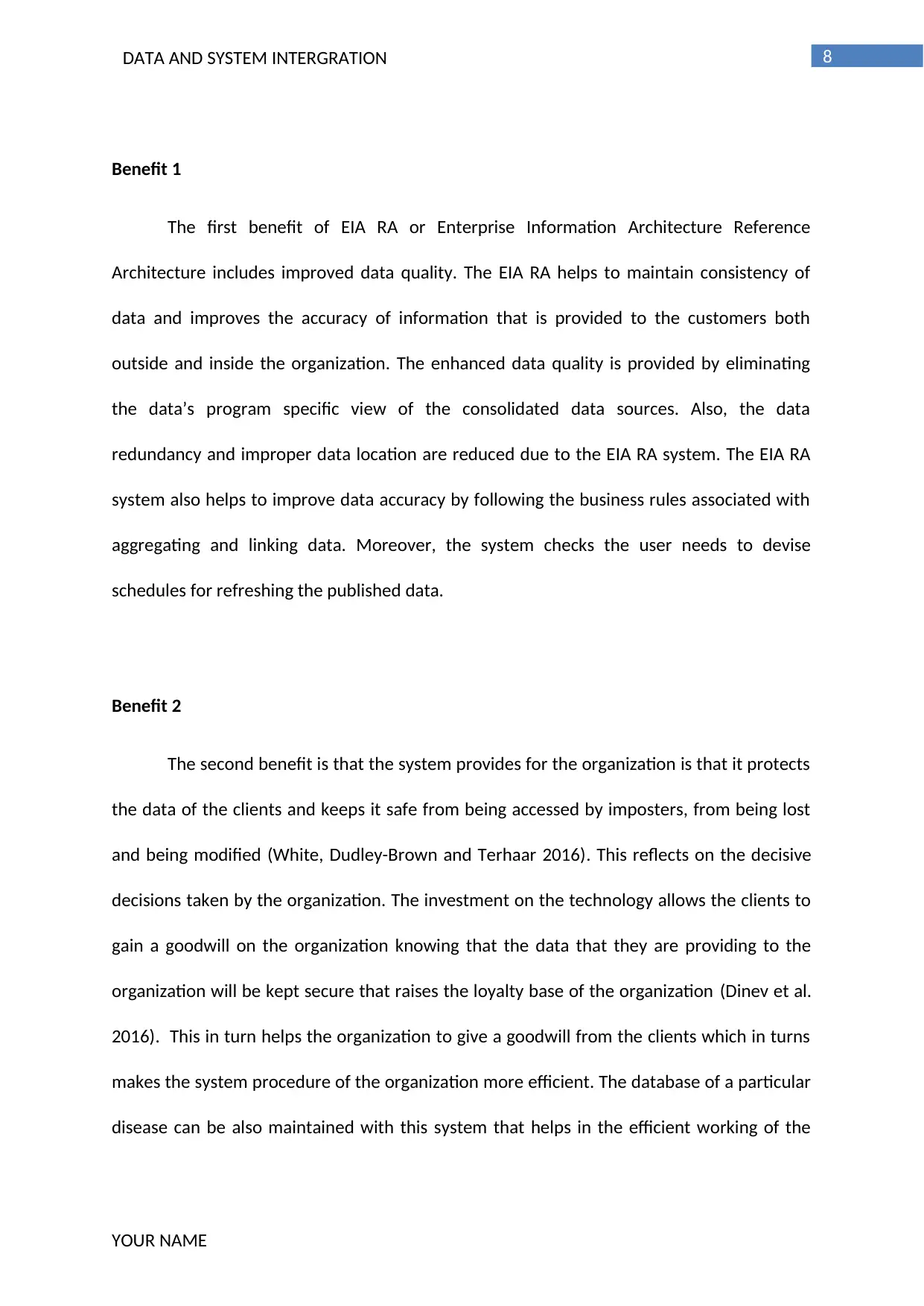
8DATA AND SYSTEM INTERGRATION
Benefit 1
The first benefit of EIA RA or Enterprise Information Architecture Reference
Architecture includes improved data quality. The EIA RA helps to maintain consistency of
data and improves the accuracy of information that is provided to the customers both
outside and inside the organization. The enhanced data quality is provided by eliminating
the data’s program specific view of the consolidated data sources. Also, the data
redundancy and improper data location are reduced due to the EIA RA system. The EIA RA
system also helps to improve data accuracy by following the business rules associated with
aggregating and linking data. Moreover, the system checks the user needs to devise
schedules for refreshing the published data.
Benefit 2
The second benefit is that the system provides for the organization is that it protects
the data of the clients and keeps it safe from being accessed by imposters, from being lost
and being modified (White, Dudley-Brown and Terhaar 2016). This reflects on the decisive
decisions taken by the organization. The investment on the technology allows the clients to
gain a goodwill on the organization knowing that the data that they are providing to the
organization will be kept secure that raises the loyalty base of the organization (Dinev et al.
2016). This in turn helps the organization to give a goodwill from the clients which in turns
makes the system procedure of the organization more efficient. The database of a particular
disease can be also maintained with this system that helps in the efficient working of the
YOUR NAME
Benefit 1
The first benefit of EIA RA or Enterprise Information Architecture Reference
Architecture includes improved data quality. The EIA RA helps to maintain consistency of
data and improves the accuracy of information that is provided to the customers both
outside and inside the organization. The enhanced data quality is provided by eliminating
the data’s program specific view of the consolidated data sources. Also, the data
redundancy and improper data location are reduced due to the EIA RA system. The EIA RA
system also helps to improve data accuracy by following the business rules associated with
aggregating and linking data. Moreover, the system checks the user needs to devise
schedules for refreshing the published data.
Benefit 2
The second benefit is that the system provides for the organization is that it protects
the data of the clients and keeps it safe from being accessed by imposters, from being lost
and being modified (White, Dudley-Brown and Terhaar 2016). This reflects on the decisive
decisions taken by the organization. The investment on the technology allows the clients to
gain a goodwill on the organization knowing that the data that they are providing to the
organization will be kept secure that raises the loyalty base of the organization (Dinev et al.
2016). This in turn helps the organization to give a goodwill from the clients which in turns
makes the system procedure of the organization more efficient. The database of a particular
disease can be also maintained with this system that helps in the efficient working of the
YOUR NAME
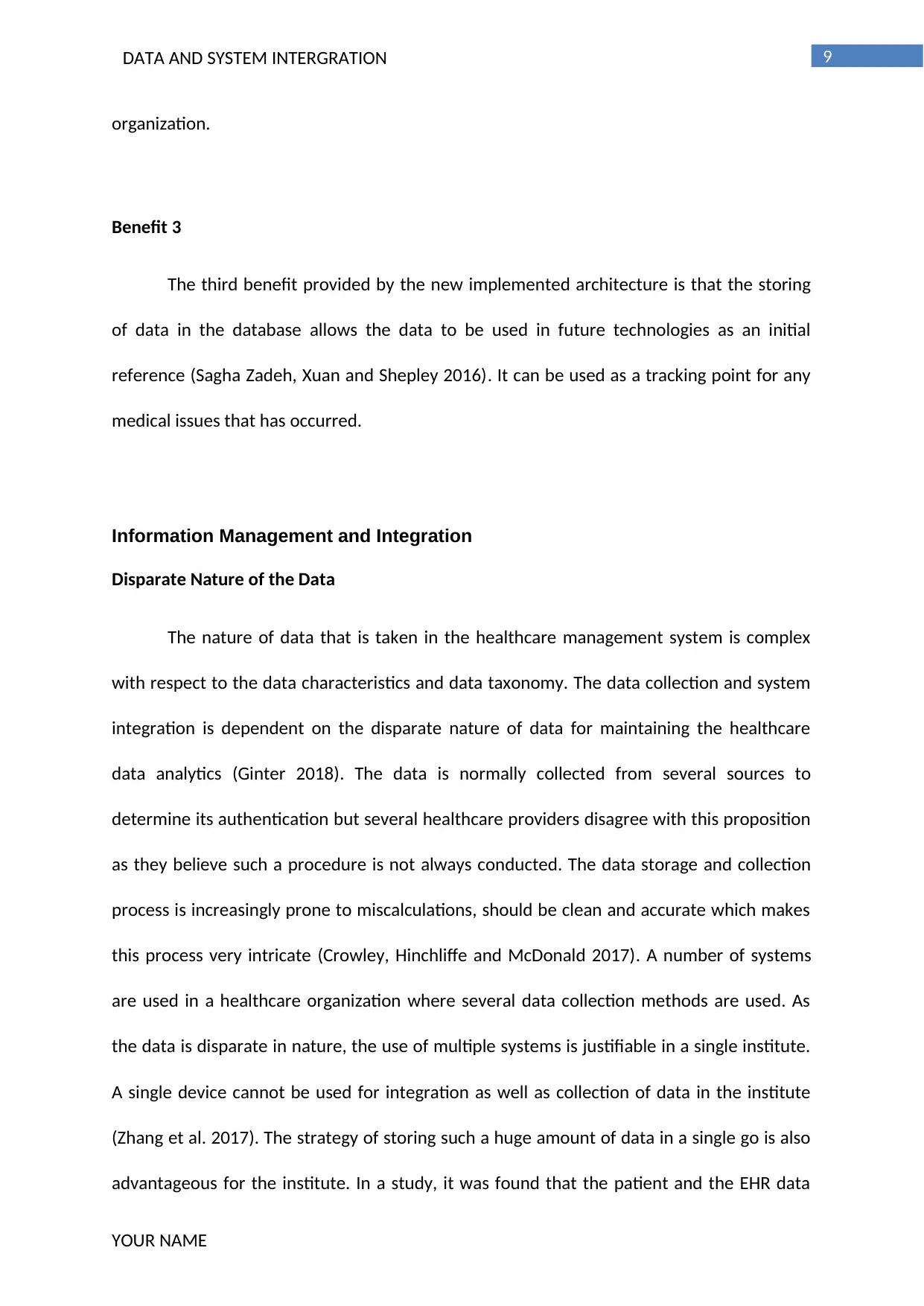
9DATA AND SYSTEM INTERGRATION
organization.
Benefit 3
The third benefit provided by the new implemented architecture is that the storing
of data in the database allows the data to be used in future technologies as an initial
reference (Sagha Zadeh, Xuan and Shepley 2016). It can be used as a tracking point for any
medical issues that has occurred.
Information Management and Integration
Disparate Nature of the Data
The nature of data that is taken in the healthcare management system is complex
with respect to the data characteristics and data taxonomy. The data collection and system
integration is dependent on the disparate nature of data for maintaining the healthcare
data analytics (Ginter 2018). The data is normally collected from several sources to
determine its authentication but several healthcare providers disagree with this proposition
as they believe such a procedure is not always conducted. The data storage and collection
process is increasingly prone to miscalculations, should be clean and accurate which makes
this process very intricate (Crowley, Hinchliffe and McDonald 2017). A number of systems
are used in a healthcare organization where several data collection methods are used. As
the data is disparate in nature, the use of multiple systems is justifiable in a single institute.
A single device cannot be used for integration as well as collection of data in the institute
(Zhang et al. 2017). The strategy of storing such a huge amount of data in a single go is also
advantageous for the institute. In a study, it was found that the patient and the EHR data
YOUR NAME
organization.
Benefit 3
The third benefit provided by the new implemented architecture is that the storing
of data in the database allows the data to be used in future technologies as an initial
reference (Sagha Zadeh, Xuan and Shepley 2016). It can be used as a tracking point for any
medical issues that has occurred.
Information Management and Integration
Disparate Nature of the Data
The nature of data that is taken in the healthcare management system is complex
with respect to the data characteristics and data taxonomy. The data collection and system
integration is dependent on the disparate nature of data for maintaining the healthcare
data analytics (Ginter 2018). The data is normally collected from several sources to
determine its authentication but several healthcare providers disagree with this proposition
as they believe such a procedure is not always conducted. The data storage and collection
process is increasingly prone to miscalculations, should be clean and accurate which makes
this process very intricate (Crowley, Hinchliffe and McDonald 2017). A number of systems
are used in a healthcare organization where several data collection methods are used. As
the data is disparate in nature, the use of multiple systems is justifiable in a single institute.
A single device cannot be used for integration as well as collection of data in the institute
(Zhang et al. 2017). The strategy of storing such a huge amount of data in a single go is also
advantageous for the institute. In a study, it was found that the patient and the EHR data
YOUR NAME
Secure Best Marks with AI Grader
Need help grading? Try our AI Grader for instant feedback on your assignments.
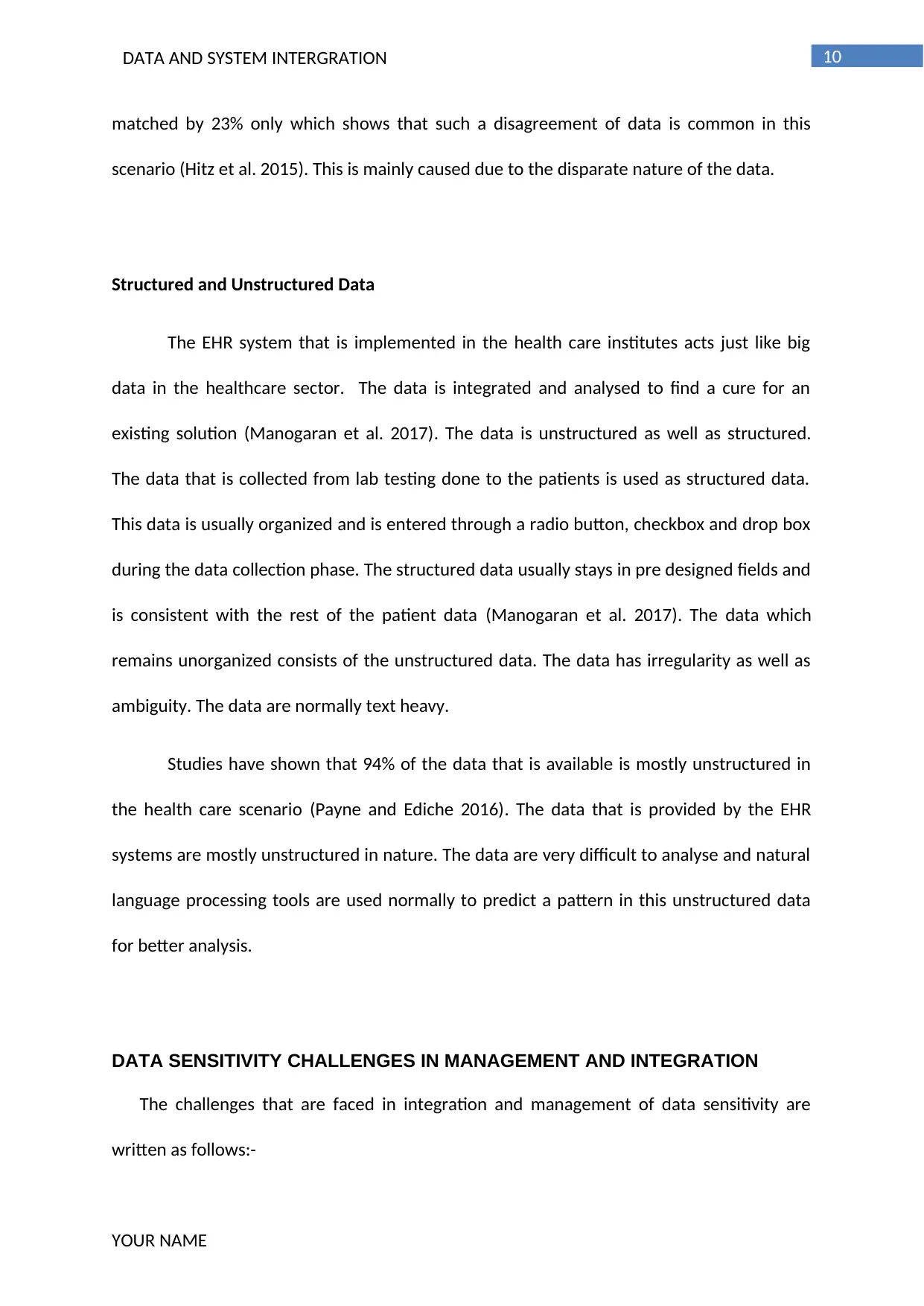
10DATA AND SYSTEM INTERGRATION
matched by 23% only which shows that such a disagreement of data is common in this
scenario (Hitz et al. 2015). This is mainly caused due to the disparate nature of the data.
Structured and Unstructured Data
The EHR system that is implemented in the health care institutes acts just like big
data in the healthcare sector. The data is integrated and analysed to find a cure for an
existing solution (Manogaran et al. 2017). The data is unstructured as well as structured.
The data that is collected from lab testing done to the patients is used as structured data.
This data is usually organized and is entered through a radio button, checkbox and drop box
during the data collection phase. The structured data usually stays in pre designed fields and
is consistent with the rest of the patient data (Manogaran et al. 2017). The data which
remains unorganized consists of the unstructured data. The data has irregularity as well as
ambiguity. The data are normally text heavy.
Studies have shown that 94% of the data that is available is mostly unstructured in
the health care scenario (Payne and Ediche 2016). The data that is provided by the EHR
systems are mostly unstructured in nature. The data are very difficult to analyse and natural
language processing tools are used normally to predict a pattern in this unstructured data
for better analysis.
DATA SENSITIVITY CHALLENGES IN MANAGEMENT AND INTEGRATION
The challenges that are faced in integration and management of data sensitivity are
written as follows:-
YOUR NAME
matched by 23% only which shows that such a disagreement of data is common in this
scenario (Hitz et al. 2015). This is mainly caused due to the disparate nature of the data.
Structured and Unstructured Data
The EHR system that is implemented in the health care institutes acts just like big
data in the healthcare sector. The data is integrated and analysed to find a cure for an
existing solution (Manogaran et al. 2017). The data is unstructured as well as structured.
The data that is collected from lab testing done to the patients is used as structured data.
This data is usually organized and is entered through a radio button, checkbox and drop box
during the data collection phase. The structured data usually stays in pre designed fields and
is consistent with the rest of the patient data (Manogaran et al. 2017). The data which
remains unorganized consists of the unstructured data. The data has irregularity as well as
ambiguity. The data are normally text heavy.
Studies have shown that 94% of the data that is available is mostly unstructured in
the health care scenario (Payne and Ediche 2016). The data that is provided by the EHR
systems are mostly unstructured in nature. The data are very difficult to analyse and natural
language processing tools are used normally to predict a pattern in this unstructured data
for better analysis.
DATA SENSITIVITY CHALLENGES IN MANAGEMENT AND INTEGRATION
The challenges that are faced in integration and management of data sensitivity are
written as follows:-
YOUR NAME
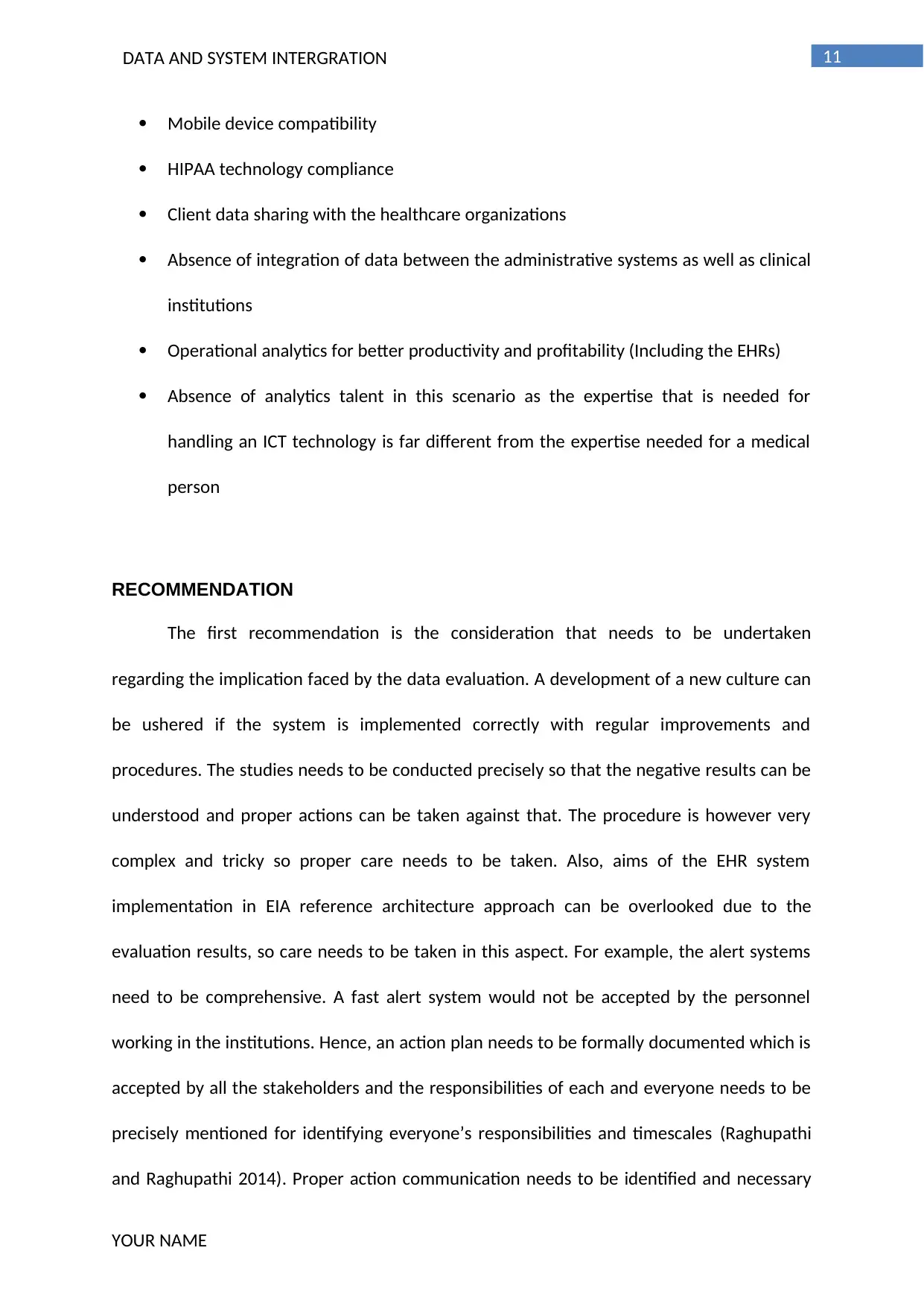
11DATA AND SYSTEM INTERGRATION
Mobile device compatibility
HIPAA technology compliance
Client data sharing with the healthcare organizations
Absence of integration of data between the administrative systems as well as clinical
institutions
Operational analytics for better productivity and profitability (Including the EHRs)
Absence of analytics talent in this scenario as the expertise that is needed for
handling an ICT technology is far different from the expertise needed for a medical
person
RECOMMENDATION
The first recommendation is the consideration that needs to be undertaken
regarding the implication faced by the data evaluation. A development of a new culture can
be ushered if the system is implemented correctly with regular improvements and
procedures. The studies needs to be conducted precisely so that the negative results can be
understood and proper actions can be taken against that. The procedure is however very
complex and tricky so proper care needs to be taken. Also, aims of the EHR system
implementation in EIA reference architecture approach can be overlooked due to the
evaluation results, so care needs to be taken in this aspect. For example, the alert systems
need to be comprehensive. A fast alert system would not be accepted by the personnel
working in the institutions. Hence, an action plan needs to be formally documented which is
accepted by all the stakeholders and the responsibilities of each and everyone needs to be
precisely mentioned for identifying everyone’s responsibilities and timescales (Raghupathi
and Raghupathi 2014). Proper action communication needs to be identified and necessary
YOUR NAME
Mobile device compatibility
HIPAA technology compliance
Client data sharing with the healthcare organizations
Absence of integration of data between the administrative systems as well as clinical
institutions
Operational analytics for better productivity and profitability (Including the EHRs)
Absence of analytics talent in this scenario as the expertise that is needed for
handling an ICT technology is far different from the expertise needed for a medical
person
RECOMMENDATION
The first recommendation is the consideration that needs to be undertaken
regarding the implication faced by the data evaluation. A development of a new culture can
be ushered if the system is implemented correctly with regular improvements and
procedures. The studies needs to be conducted precisely so that the negative results can be
understood and proper actions can be taken against that. The procedure is however very
complex and tricky so proper care needs to be taken. Also, aims of the EHR system
implementation in EIA reference architecture approach can be overlooked due to the
evaluation results, so care needs to be taken in this aspect. For example, the alert systems
need to be comprehensive. A fast alert system would not be accepted by the personnel
working in the institutions. Hence, an action plan needs to be formally documented which is
accepted by all the stakeholders and the responsibilities of each and everyone needs to be
precisely mentioned for identifying everyone’s responsibilities and timescales (Raghupathi
and Raghupathi 2014). Proper action communication needs to be identified and necessary
YOUR NAME
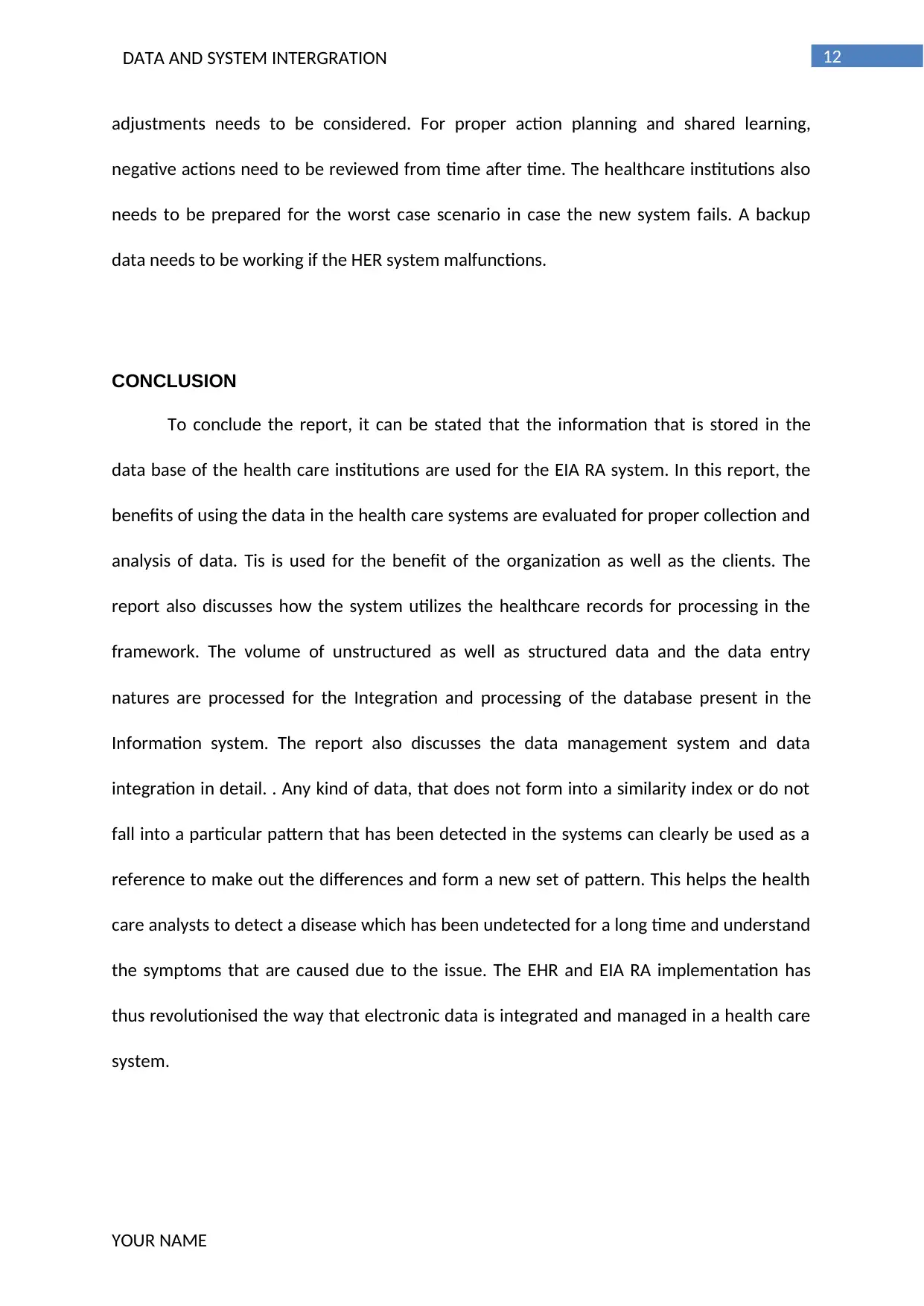
12DATA AND SYSTEM INTERGRATION
adjustments needs to be considered. For proper action planning and shared learning,
negative actions need to be reviewed from time after time. The healthcare institutions also
needs to be prepared for the worst case scenario in case the new system fails. A backup
data needs to be working if the HER system malfunctions.
CONCLUSION
To conclude the report, it can be stated that the information that is stored in the
data base of the health care institutions are used for the EIA RA system. In this report, the
benefits of using the data in the health care systems are evaluated for proper collection and
analysis of data. Tis is used for the benefit of the organization as well as the clients. The
report also discusses how the system utilizes the healthcare records for processing in the
framework. The volume of unstructured as well as structured data and the data entry
natures are processed for the Integration and processing of the database present in the
Information system. The report also discusses the data management system and data
integration in detail. . Any kind of data, that does not form into a similarity index or do not
fall into a particular pattern that has been detected in the systems can clearly be used as a
reference to make out the differences and form a new set of pattern. This helps the health
care analysts to detect a disease which has been undetected for a long time and understand
the symptoms that are caused due to the issue. The EHR and EIA RA implementation has
thus revolutionised the way that electronic data is integrated and managed in a health care
system.
YOUR NAME
adjustments needs to be considered. For proper action planning and shared learning,
negative actions need to be reviewed from time after time. The healthcare institutions also
needs to be prepared for the worst case scenario in case the new system fails. A backup
data needs to be working if the HER system malfunctions.
CONCLUSION
To conclude the report, it can be stated that the information that is stored in the
data base of the health care institutions are used for the EIA RA system. In this report, the
benefits of using the data in the health care systems are evaluated for proper collection and
analysis of data. Tis is used for the benefit of the organization as well as the clients. The
report also discusses how the system utilizes the healthcare records for processing in the
framework. The volume of unstructured as well as structured data and the data entry
natures are processed for the Integration and processing of the database present in the
Information system. The report also discusses the data management system and data
integration in detail. . Any kind of data, that does not form into a similarity index or do not
fall into a particular pattern that has been detected in the systems can clearly be used as a
reference to make out the differences and form a new set of pattern. This helps the health
care analysts to detect a disease which has been undetected for a long time and understand
the symptoms that are caused due to the issue. The EHR and EIA RA implementation has
thus revolutionised the way that electronic data is integrated and managed in a health care
system.
YOUR NAME
Paraphrase This Document
Need a fresh take? Get an instant paraphrase of this document with our AI Paraphraser
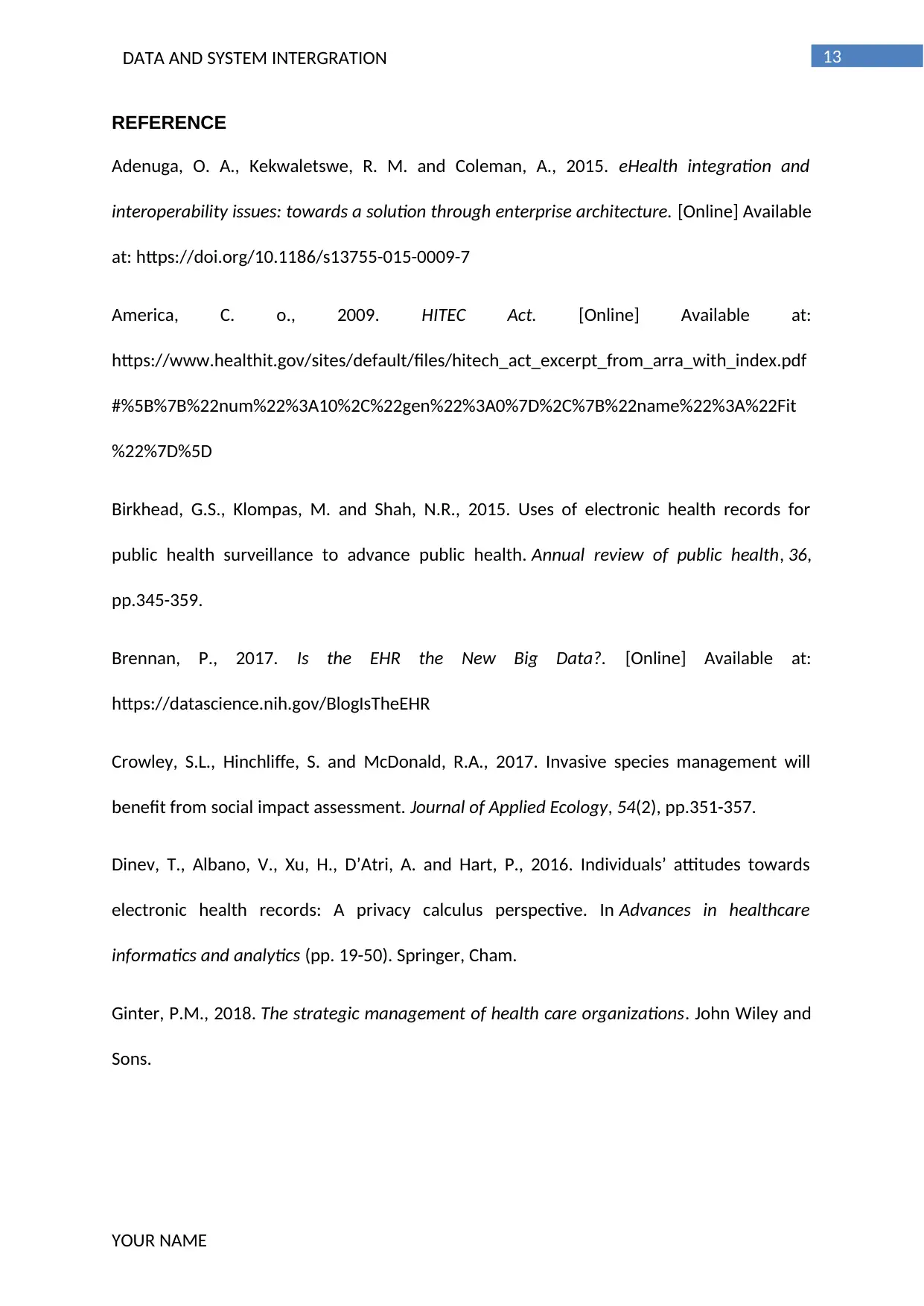
13DATA AND SYSTEM INTERGRATION
REFERENCE
Adenuga, O. A., Kekwaletswe, R. M. and Coleman, A., 2015. eHealth integration and
interoperability issues: towards a solution through enterprise architecture. [Online] Available
at: https://doi.org/10.1186/s13755-015-0009-7
America, C. o., 2009. HITEC Act. [Online] Available at:
https://www.healthit.gov/sites/default/files/hitech_act_excerpt_from_arra_with_index.pdf
#%5B%7B%22num%22%3A10%2C%22gen%22%3A0%7D%2C%7B%22name%22%3A%22Fit
%22%7D%5D
Birkhead, G.S., Klompas, M. and Shah, N.R., 2015. Uses of electronic health records for
public health surveillance to advance public health. Annual review of public health, 36,
pp.345-359.
Brennan, P., 2017. Is the EHR the New Big Data?. [Online] Available at:
https://datascience.nih.gov/BlogIsTheEHR
Crowley, S.L., Hinchliffe, S. and McDonald, R.A., 2017. Invasive species management will
benefit from social impact assessment. Journal of Applied Ecology, 54(2), pp.351-357.
Dinev, T., Albano, V., Xu, H., D’Atri, A. and Hart, P., 2016. Individuals’ attitudes towards
electronic health records: A privacy calculus perspective. In Advances in healthcare
informatics and analytics (pp. 19-50). Springer, Cham.
Ginter, P.M., 2018. The strategic management of health care organizations. John Wiley and
Sons.
YOUR NAME
REFERENCE
Adenuga, O. A., Kekwaletswe, R. M. and Coleman, A., 2015. eHealth integration and
interoperability issues: towards a solution through enterprise architecture. [Online] Available
at: https://doi.org/10.1186/s13755-015-0009-7
America, C. o., 2009. HITEC Act. [Online] Available at:
https://www.healthit.gov/sites/default/files/hitech_act_excerpt_from_arra_with_index.pdf
#%5B%7B%22num%22%3A10%2C%22gen%22%3A0%7D%2C%7B%22name%22%3A%22Fit
%22%7D%5D
Birkhead, G.S., Klompas, M. and Shah, N.R., 2015. Uses of electronic health records for
public health surveillance to advance public health. Annual review of public health, 36,
pp.345-359.
Brennan, P., 2017. Is the EHR the New Big Data?. [Online] Available at:
https://datascience.nih.gov/BlogIsTheEHR
Crowley, S.L., Hinchliffe, S. and McDonald, R.A., 2017. Invasive species management will
benefit from social impact assessment. Journal of Applied Ecology, 54(2), pp.351-357.
Dinev, T., Albano, V., Xu, H., D’Atri, A. and Hart, P., 2016. Individuals’ attitudes towards
electronic health records: A privacy calculus perspective. In Advances in healthcare
informatics and analytics (pp. 19-50). Springer, Cham.
Ginter, P.M., 2018. The strategic management of health care organizations. John Wiley and
Sons.
YOUR NAME
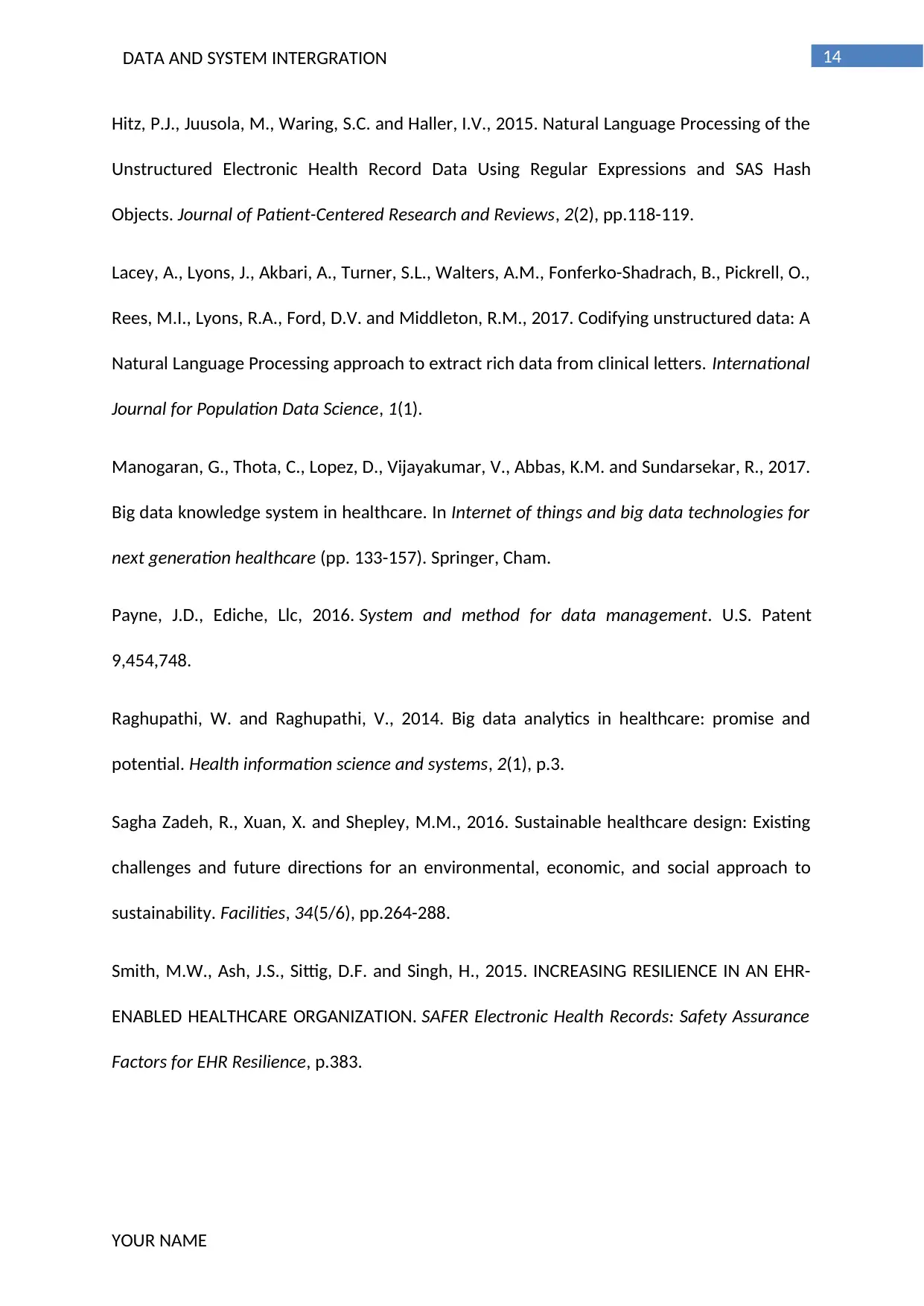
14DATA AND SYSTEM INTERGRATION
Hitz, P.J., Juusola, M., Waring, S.C. and Haller, I.V., 2015. Natural Language Processing of the
Unstructured Electronic Health Record Data Using Regular Expressions and SAS Hash
Objects. Journal of Patient-Centered Research and Reviews, 2(2), pp.118-119.
Lacey, A., Lyons, J., Akbari, A., Turner, S.L., Walters, A.M., Fonferko-Shadrach, B., Pickrell, O.,
Rees, M.I., Lyons, R.A., Ford, D.V. and Middleton, R.M., 2017. Codifying unstructured data: A
Natural Language Processing approach to extract rich data from clinical letters. International
Journal for Population Data Science, 1(1).
Manogaran, G., Thota, C., Lopez, D., Vijayakumar, V., Abbas, K.M. and Sundarsekar, R., 2017.
Big data knowledge system in healthcare. In Internet of things and big data technologies for
next generation healthcare (pp. 133-157). Springer, Cham.
Payne, J.D., Ediche, Llc, 2016. System and method for data management. U.S. Patent
9,454,748.
Raghupathi, W. and Raghupathi, V., 2014. Big data analytics in healthcare: promise and
potential. Health information science and systems, 2(1), p.3.
Sagha Zadeh, R., Xuan, X. and Shepley, M.M., 2016. Sustainable healthcare design: Existing
challenges and future directions for an environmental, economic, and social approach to
sustainability. Facilities, 34(5/6), pp.264-288.
Smith, M.W., Ash, J.S., Sittig, D.F. and Singh, H., 2015. INCREASING RESILIENCE IN AN EHR-
ENABLED HEALTHCARE ORGANIZATION. SAFER Electronic Health Records: Safety Assurance
Factors for EHR Resilience, p.383.
YOUR NAME
Hitz, P.J., Juusola, M., Waring, S.C. and Haller, I.V., 2015. Natural Language Processing of the
Unstructured Electronic Health Record Data Using Regular Expressions and SAS Hash
Objects. Journal of Patient-Centered Research and Reviews, 2(2), pp.118-119.
Lacey, A., Lyons, J., Akbari, A., Turner, S.L., Walters, A.M., Fonferko-Shadrach, B., Pickrell, O.,
Rees, M.I., Lyons, R.A., Ford, D.V. and Middleton, R.M., 2017. Codifying unstructured data: A
Natural Language Processing approach to extract rich data from clinical letters. International
Journal for Population Data Science, 1(1).
Manogaran, G., Thota, C., Lopez, D., Vijayakumar, V., Abbas, K.M. and Sundarsekar, R., 2017.
Big data knowledge system in healthcare. In Internet of things and big data technologies for
next generation healthcare (pp. 133-157). Springer, Cham.
Payne, J.D., Ediche, Llc, 2016. System and method for data management. U.S. Patent
9,454,748.
Raghupathi, W. and Raghupathi, V., 2014. Big data analytics in healthcare: promise and
potential. Health information science and systems, 2(1), p.3.
Sagha Zadeh, R., Xuan, X. and Shepley, M.M., 2016. Sustainable healthcare design: Existing
challenges and future directions for an environmental, economic, and social approach to
sustainability. Facilities, 34(5/6), pp.264-288.
Smith, M.W., Ash, J.S., Sittig, D.F. and Singh, H., 2015. INCREASING RESILIENCE IN AN EHR-
ENABLED HEALTHCARE ORGANIZATION. SAFER Electronic Health Records: Safety Assurance
Factors for EHR Resilience, p.383.
YOUR NAME
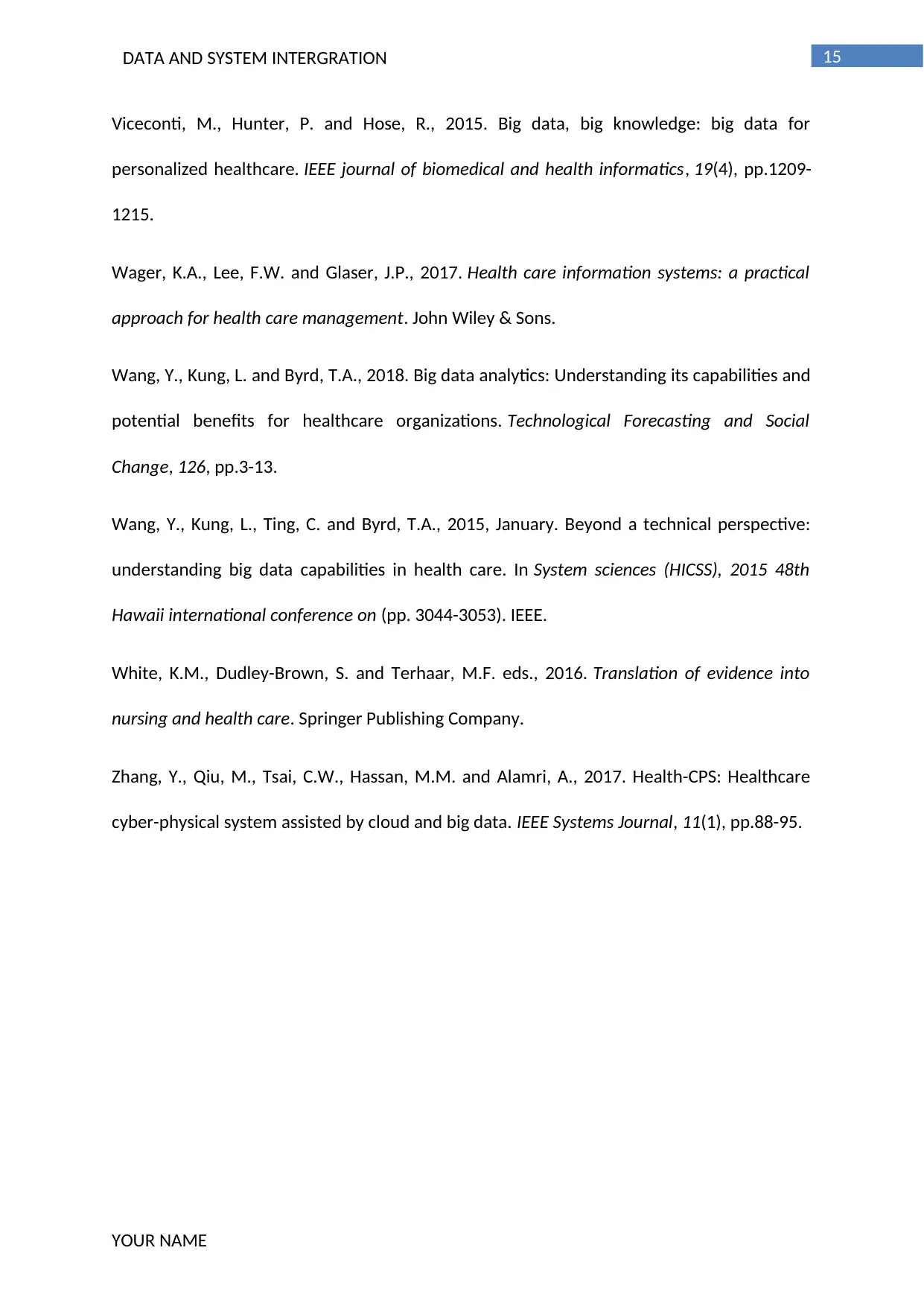
15DATA AND SYSTEM INTERGRATION
Viceconti, M., Hunter, P. and Hose, R., 2015. Big data, big knowledge: big data for
personalized healthcare. IEEE journal of biomedical and health informatics, 19(4), pp.1209-
1215.
Wager, K.A., Lee, F.W. and Glaser, J.P., 2017. Health care information systems: a practical
approach for health care management. John Wiley & Sons.
Wang, Y., Kung, L. and Byrd, T.A., 2018. Big data analytics: Understanding its capabilities and
potential benefits for healthcare organizations. Technological Forecasting and Social
Change, 126, pp.3-13.
Wang, Y., Kung, L., Ting, C. and Byrd, T.A., 2015, January. Beyond a technical perspective:
understanding big data capabilities in health care. In System sciences (HICSS), 2015 48th
Hawaii international conference on (pp. 3044-3053). IEEE.
White, K.M., Dudley-Brown, S. and Terhaar, M.F. eds., 2016. Translation of evidence into
nursing and health care. Springer Publishing Company.
Zhang, Y., Qiu, M., Tsai, C.W., Hassan, M.M. and Alamri, A., 2017. Health-CPS: Healthcare
cyber-physical system assisted by cloud and big data. IEEE Systems Journal, 11(1), pp.88-95.
YOUR NAME
Viceconti, M., Hunter, P. and Hose, R., 2015. Big data, big knowledge: big data for
personalized healthcare. IEEE journal of biomedical and health informatics, 19(4), pp.1209-
1215.
Wager, K.A., Lee, F.W. and Glaser, J.P., 2017. Health care information systems: a practical
approach for health care management. John Wiley & Sons.
Wang, Y., Kung, L. and Byrd, T.A., 2018. Big data analytics: Understanding its capabilities and
potential benefits for healthcare organizations. Technological Forecasting and Social
Change, 126, pp.3-13.
Wang, Y., Kung, L., Ting, C. and Byrd, T.A., 2015, January. Beyond a technical perspective:
understanding big data capabilities in health care. In System sciences (HICSS), 2015 48th
Hawaii international conference on (pp. 3044-3053). IEEE.
White, K.M., Dudley-Brown, S. and Terhaar, M.F. eds., 2016. Translation of evidence into
nursing and health care. Springer Publishing Company.
Zhang, Y., Qiu, M., Tsai, C.W., Hassan, M.M. and Alamri, A., 2017. Health-CPS: Healthcare
cyber-physical system assisted by cloud and big data. IEEE Systems Journal, 11(1), pp.88-95.
YOUR NAME
1 out of 16
Related Documents
Your All-in-One AI-Powered Toolkit for Academic Success.
+13062052269
info@desklib.com
Available 24*7 on WhatsApp / Email
![[object Object]](/_next/static/media/star-bottom.7253800d.svg)
Unlock your academic potential
© 2024 | Zucol Services PVT LTD | All rights reserved.




